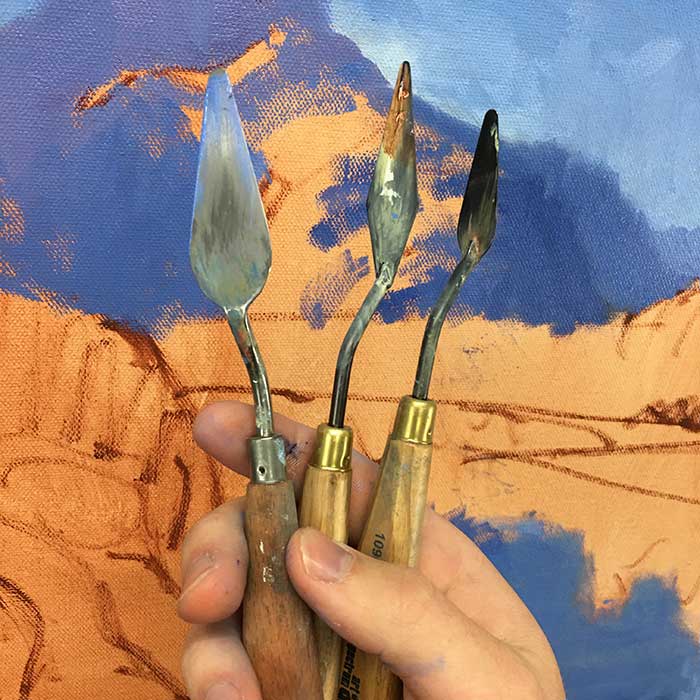Last updated on January 18th, 2024 at 04:20 am
Artists of all levels need palette knives. For decades, these adaptable instruments have let painters express their creativity in unusual and exciting ways.
This essay will explore palette knives, their history, applications, and aesthetic potential. What is a palette knife, and how can it improve your art? Jump in!
What is a Palette Knife?
An artist blends and spreads paint with a palette knife. Palette knives have a handle and a flat, flexible metal blade, unlike paintbrushes. Stainless steel blades are durable and easy to maintain.
The Versatility of Palette Knives

Palette knives’ adaptability gives painters many creative options. Let’s look at some of palette knives’ most popular uses:
Mixing Colours
Palette knives combine colours well. Artists may combine colours precisely with the flat blade, generating bespoke colours and clean gradients. Artists can better control their colour palettes by mixing colours on the palette instead on the canvas.
Impasto Technique
Impasto creates a three-dimensional look by adding thick paint to the canvas. Palette knives are suitable for this technique because their hard blades allow painters to apply paint thickly and controllably, creating remarkable texture and depth.
Bold, Expressive Strokes
Palette knives’ strong and expressive strokes are fascinating. Sharp, defined lines from the blade’s flat edge can give a painting energy. Artists can create tiny wisps to forceful, sweeping strokes by changing pressure and angle.
Glazing Scumbling
Palette knives are great for scumbling and glazing. Scumbling creates a soft, ambient appearance by placing a thin layer of opaque or semi-opaque paint over a dried layer. Glazing enhances colour intensity and depth by applying transparent or translucent layers of paint. Palette knives let painters manipulate these effects.
Texture Effects
Palette knives offer endless possibilities for texture-loving painters. Artists can create rough and gritty to smooth and flowing textures by applying paint in thick, sculptural strokes. Palette knives can create stunning textured effects like tree bark or water ripples.
Techniques and Tips for Using Palette Knives

Palette knives’ aesthetic potential can only be realised by mastering diverse techniques. Palette knife usage advice:
Change Blades
Each palette knife has unique qualities. Pointed blades enable for exact details, while flat blades combine colours and create smooth surfaces. Trowel-shaped blades are ideal for thick impasto. Experimenting with blade shapes will reveal new possibilities and match your artistic style.
Pressure and Angles
By changing pressure and angle, palette knife painters can create varied effects. More pressure on the blade generates larger, bolder strokes, while lighter pressure produces delicate, wispy traces. Angling the knife changes the stroke shape and direction, adding diversity and expressive potential.
Texture and Movement
Palette knife painting can uniquely capture texture and movement. Artists can create visually appealing surfaces by applying thick, textured paint with the knife. The painting’s sculptural quality provides depth and movement.
Different Surfaces
Palette knives are not limited to canvases. To experiment and explore new creative possibilities, artists paint on wood, metal, or textured papers. Each surface interacts with the palette knife differently, giving artists limitless opportunity to experiment.
Brushes and Palette Knife
Palette knives can be used alone or with brushes to produce vibrant, textured paintings. Artists can use palette knives to express themselves and brushes for precision and control. This enables for a balanced blend of skills and various mark-making.
Palette Knife Care
Palette knives must be cleaned and maintained to last and work well. After painting, wipe the blade with a cloth or paper towel. Use mild soap and warm water to clean the blade and handle. Clean and well-maintained palette knives are trustworthy and effective art tools.
Palette Knife FAQs
How do palette and painting knives differ?
Palette knives are used for mixing and applying paint, whereas painting knives are utilised for fine work and sculpting paint.
Palette knives for novices?
Absolutely! All artists can enjoy palette knives. They let you experiment with texture and expression.
Do I need palette knife paints?
Palette knives work with any paint. Due of their thickness, palette knife methods are most often used with oils or heavy-body acrylics.
Palette knife for delicate details?
With practise, palette knives can create detailed strokes. Brushes or other fine-tipped tools are recommended for detailed detailing.
Is a palette knife only for painting?
Palette knives aren’t just for painting. They are versatile for sculpting, ceramics, and cake decoration.
What palette knife should I use?
Palette knives vary by preference and effect. Try numerous forms, sizes, and flexibilities to find the palette knife that complements your art.
Conclusion
Finally, artists need palette knives. Its flat, flexible blade allows blending colours, texture, and bold, expressive strokes. Artists can experiment and create stunning visual effects with a palette knife. Palette knives can improve your art whether you’re a novice or a pro.
Why wait? Take a palette knife and uncover your artistic potential. Bring your paintings to life by adding depth and texture.
